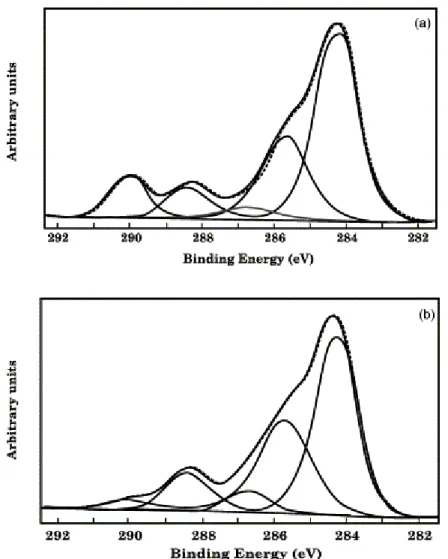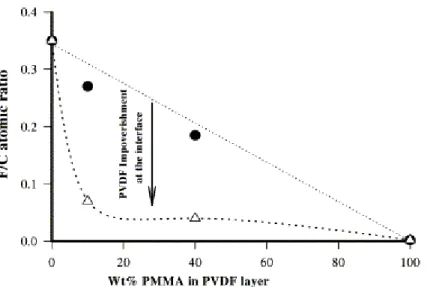Published in: Polymer (2000), vol. 41, iss. 9, pp. 3391-3394 Status: Postprint (Author’s version)
XPS analysis of the PC/PVDF interface modified by PMMA. Location of
the PMMA at the interface
N. Moussaifa, C. Pagnoullea, J. Rigab and R. Jérômea
a
Center for Education and Research on Macromolecules (CERM), University of Liège, Institute of Chemistry, B6, Sart-Tilman, 4000 Liège, Belgium
b
F. U. N. D.P., L. I. S. E, University of Namur, Rue de Bruxelles, 61 - B 5000 Namur, Belgium
Abstract
Polycarbonate (PC) and polyvinylidenefluoride (PVDF) are two immiscible polymers, which form two-phase polyblends with a weak interfacial adhesion and a high interfacial tension. This situation may be changed by the addition of polymethylmethacrylate (PMMA), which is miscible with PVDF and concentrates at the PVDF/PC interface. Location of PMMA at the PC/PVDF interface has been confirmed by XPS analysis, which shows that the interface enrichment in PMMA already takes place when only 10 wt% PMMA is premixed with PVDF.
Keywords: Polycarbonate; Polyvinylidenefluoride; Polymethylmethacrylate
1. Introduction
Previous papers [1-3] reported that polymethylmethacrylate (PMMA) is a potential compatibilizer for the immiscible polycarbonate/polyvinylidenefluoride (PC/PVDF) polyblends, since PMMA is known for miscibility with PVDF [4-6] and compatibility with PC [7-9]. As a rule, the interfacial adhesion and the interfacial tension of immiscible PC/PVDF blends are improved by the addition of PMMA [1-2], which concentrates in the PVDF rich phase, but also at the PVDF/PC interface. That a thin layer of PMMA is formed at the interface was indirectly supported by Yoon and Han [10], who measured the thickness of the PC/PMMA interface by small angle neutron scattering and reported values of 32.5 and 29.6 Å for 16 h annealing at 180 and 200°C, respectively, thus figures characteristic of diffuse interface and polymer compatibility.
The purpose of this work is to prove directly that PMMA has an interfacial activity that allows it to accumulate at the PC/PVDF interface when premixed with PVDF. After annealing of the PC/(PMMA/PVDF) bilayer assembly, the PC layer will be completely eliminated by selective chemical degradation and the chemical composition of the PVDF surface will be analyzed by XPS.
2. Experimental section
PC was MAKROLON 3103 from Bayer, PMMA was DIAKON from ICI, and PVDF was Solef X10N from Solvay. It was ascertained that PMMA did not contain acrylic acid co-units, at least within the limits of detection by IR and potentiometric titration by standard solution of tetramethylammonium hydroxide in toluene/methanol mixture. PVDF/PMMA blends were prepared by melt mixing with a two-roll mill (SCAMIA), at 200°C for 10 min. Thick samples (1 mm) of PC and PVDF/PMMA blends were prepared by compression molding at 220°C. The PVDF/PMMA blends were annealed under vacuum for 12 h at 150°C. PC/PVDF and
PC/(PMMA/PVDF) bilayer films were then prepared by compression molding and annealed at 220°C for 10 min.
The bilayer was immersed in saturated NaOH solution in methanol at 40°C until the complete removal of PC [11]. The surface of the PVDF/PMMA film was examined by X-ray photoelectron spectroscopy (XPS). For the sake of comparison, the original PVDF and PVDF/PMMA films were also analyzed by XPS.
The XPS measurements were performed with SCIENTA ESCA-300 spectrometer using an Al K(alpha) X-ray source (hν=1486.6 eV). The X-ray source was run at 2.4 kW. All core-level spectra were referred to the C1s neutral carbon peak at 284.6 eV, and recorded with a take off angle of 75°.
Published in: Polymer (2000), vol. 41, iss. 9, pp. 3391-3394 Status: Postprint (Author’s version)
3. Results and discussion
In order to assess the validity of the experimental strategy proposed in this work, it is essential to prove that, although PC is completely disintegrated by NaOH, PMMA and PVDF are not. For this purpose, films of PMMA and PVDF and PVDF/PC bilayers have been immersed in saturated NaOH solution in methanol for two days. XPS analysis has confirmed that the surface of PMMA and PVDF films has remained unchanged. Similarly, this technique has shown the complete and selective removal of the PC layer originally assembled with PVDF.
Fig. 1(a) shows the C1s spectrum for annealed 40/60 PMMA/PVDF (wt/wt) film. The same information is provided by Fig. 1(b) for the same film that has been previously assembled with PC, annealed and rid of PC before XPS analysis. These C(1s) XPS spectra [12] show five types of carbon: carbon bonded to hydrogen (CHx; 284.3 eV), carbon singly bonded to carboxyl (C–CO2–; 284.9 eV), carbon singly bonded to oxygen (–C–
O–C=O; 286.1 eV), carbon of carboxyl (O–C=O; 288.3 eV) and carbon singly bonded to fluor (C–F2; 290 eV). It
must be noted that the carbon CH2 of PVDF is significantly β shifted by the adjacent CF2 group, resulting in a
chemical shift of 1.4 eV with respect to the CH2 in PMMA (thus at binding energy of 285.7 eV).
Fig. 1. C(1s) XPS spectra for 40/60 PMMA/PVDF blends: (a) annealed in contact with the atmosphere; (b) annealed in contact with PC, for 10 min at 200°C.
In case of the annealed 40/60 PMMA/PVDF film, the C1s spectrum (Fig. 1(a)) shows the C1s peaks
characteristic of the carbon singly bonded to fluor (290 eV) and part of the carbonyl group (288.3 eV), indicating that both PMMA and PVDF are detectable on the surface. When these films have been assembled with PC before annealing, their surface shows again the presence of PVDF and PMMA (Fig. 1(b)), although the relative intensity of the characteristic carbon atoms (290 and 288.3 eV) has changed. Indeed, comparison of Fig. 1(a) with Fig. 1(b) confirms that the relative intensity of the PMMA signals compared to PVDF has increased as result of the annealing of the PVDF/PMMA film in intimate contact with PC.
Published in: Polymer (2000), vol. 41, iss. 9, pp. 3391-3394 Status: Postprint (Author’s version)
The change in the F/C atomic ratio at the PMMA/PVDF surface has been calculated from the XPS spectra in relation to the PMMA content of the PVDF layer as shown in Fig. 2. When the PVDF/PMMA films are annealed in contact with atmosphere, the F/C atomic ratio of their surface decreases as the PMMA content is increased. However, the annealing of these samples previously assembled with PC in bilayers, results in a dramatic decrease in the F/C atomic ratio even though only 10 wt% of PMMA has been preblended with PVDF, which indicates the enrichment of the PVDF surface in PMMA.
Fig. 2. F/C atomic ratio detected by XPS at the PMMA/PVDF surface versus the content of PMMA in PVDF: (•) PMMA/PVDF annealed in contact with the atmosphere; ( ) PMMA/PVDF blends annealed in contact with PC for 10 min at 220°C .
The surface chemical composition of the assembled 10/90 and 40/60 PMMA/PVDF films has been more quantitatively estimated from the F/C atomic ratio. For this purpose, the F 1s XPS peak assigned to PVDF has been normalized with respect to the C1s signal which is characteristic of both the PMMA and PVDF constitutive components. Assuming that the XPS signals of PMMA and PVDF directly reflect the chemical composition of the surface, the surface coverage of the previously assembled PMMA/PVDF films by PMMA can be extracted from the C/F atomic ratio as follows.
(1)
where C/F is the experimental atomic ratio of the scanned region, Ci and Fi being the number of C and F atoms originating from the constituent i for the same region. The percentage of carbon atoms assigned to PMMA with respect to the total number of carbons on the surface (%CPMMA) is expressed by Eq. (2) and approximated to the
wt% of PMMA on that surface:
%CPMMA=100CPMMA/(CPMMA+CPVDF)=100CPMMA/Ctotal. (2)
The experimental CPVDF/FPVDF ratio is 2.85 for neat PVDF, instead of one as expected from the F/C
stochiometric ratio of PVDF. This apparent discrepancy results from the higher XPS sensitivity of fluoride element. Thus CPMMA can be expressed by Eq. (3).
CPMMA=Ctotal−CPVDF=Ctotal−2.85Ftotal (3)
thus,
(4)
Published in: Polymer (2000), vol. 41, iss. 9, pp. 3391-3394 Status: Postprint (Author’s version)
(5)
After annealing of the PC/(PVDF+PMMA) assemblies and complete cleaning of the (PVDF+PMMA) surface, it comes out that this surface consists of 80 and 90 wt% PMMA for the original (PVDF+PPMA) films containing 10 and 40 wt% of PMMA. Thus the coverage of the PVDF surface by PMMA is close to completeness when PVDF is premixed with only 10 wt% of PMMA, the driving force being the decrease of the PC/PVDF interfacial tension by PMMA. Indeed, the PC/PMMA interfacial tension is 0.6 dyne/cm, thus much smaller than the PC/PVDF one (4.5 dyne/cm) [2].
This conclusion is in apparent contradiction with the experimental dependence of the PC/(PVDF+PMMA) interfacial tension and interfacial adhesion on the PMMA content in PVDF [1-2]. These data indicated that ca. 35 wt% of PMMA in PVDF was necessary to substitute the original PC/PVDF interface by a PC/PMMA one. The origin for this discrepancy has to be found, at least partly, in the diffuseness of the PC/PMMA interface. Therefore, when the PC/(PVDF+PMMA) bilayer is removed, the PMMA chains originally part of the diffuse interface collapse on the PVDF surface, which appears to be more extensively and completely covered by PMMA than it is in the actual bilayer.
This dependence of the surface composition on the PMMA content in PVDF clearly shows that PMMA migrates and accumulates at the PC/PVDF interface. Indeed, a PMMA surface is nearly substituted for the original PMMA/PVDF surface when at least ca. 10 wt% is mixed within PVDF.
The surface coverage of PVDF by PMMA does not change significantly with the original content of PMMA in PVDF (10 and 40 wt%). A reasonable explanation might be that the thickness of the PMMA layer formed on top of PVDF (after PC removal) exceeds the depth probed by the XPS technique, thus from 10 to 200 Å in case of polymers [13], such that PVDF beneath this thin PMMA layer remains detectable in small and apparently constant percentage.
In conclusion, XPS analysis provides evidence for the coverage of the PC/PVDF interface by PMMA when PVDF is preblended with as small as 10 wt% of PMMA. However, the complete removal of PC before the XPS analysis of the PVDF surface leads to the collapse on this surface of the PMMA chains that were originally part of a PC/PMMA diffuse region and contributed to the physical properties of the actual PC/PVDF interface, i.e. interfacial tension and interfacial adhesion. It is thus not surprising that the PC/PVDF interface appears to be saturated by PMMA when only 10 wt% of PMMA is preblended with PVDF and the surface composition of the PVDF phase is analyzed by XPS, although measurement of the macroscopic properties of the real interface indicates that ca. 35 wt% of PMMA is required.
Acknowledgements
The authors are very grateful to the "Services Fédéraux des Affaires Scientifiques, Techniques et Culturelles" for support in the framework of the "Pôles d'Attraction Interuniversitaires: PAI 4/11". N. M. is indebted to the "Ministère de l'Enseignement Superieur de la Formation des Cadres et de la Recherche Scientifique du Maroc" for a fellowship.
References
[1] Moussaif N, Maréchal Ph, Jérôme R. Macromolecules 1997;30:658. [2] Moussaif N, Jerome R. Macromolecular Symposia 1999; in press. [3] Moussaif N, Jérôme R. Polymer 1999;40:3919.
[4] Tpmura H, Saito H, Inoue T. Macromolecules 1987;25(5):1611. [5] Prud'Homme RE. Polym Eng Sci 1982;22:90.
[6] Flory PJ. J Am Chem Soc 1965;87:1833.
[7] Kim WN, Burns CM. Macromolecules 1987;20:1876.
[8] Chiou JS, Barlow JW, Paul DR. J Polym Sci, Polym Phys Ed1987;25:1459.
[9] Gardlund ZG. Polymer blends and composites in multiphase systems. In: Han CD, editor. Advances in chemistry series, Washington, DC: American Chemical Society, 1984.
[10] Yoon H, Han CC. Polym Eng Sci 1995;35(18):1476.
[11] Lian-Chun Hu, Oku Ak, Yamada Et. Polymer 1998;39(16):3841.
[12] Beamson G, Briggs D. High resolution XPS of organic polymers: thescienta ESCA300 database, Chichester, UK: Wiley, 1992. [13] Nebesney KW, Masschof BL, Armstrong NR. Anal Chem 1989;61:589A.

